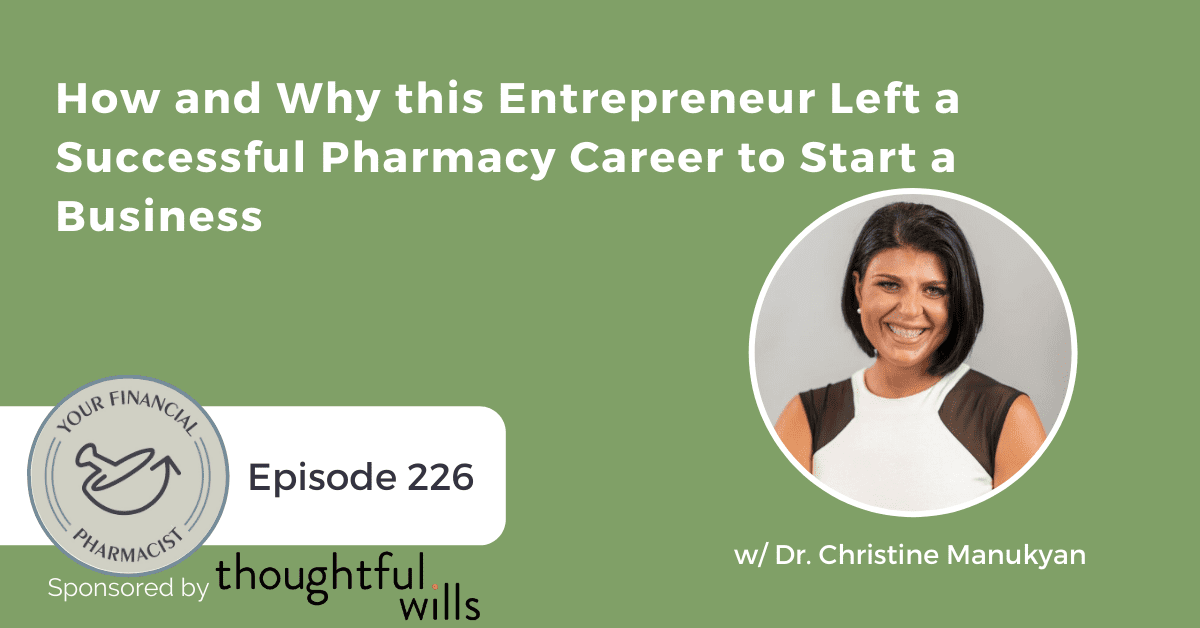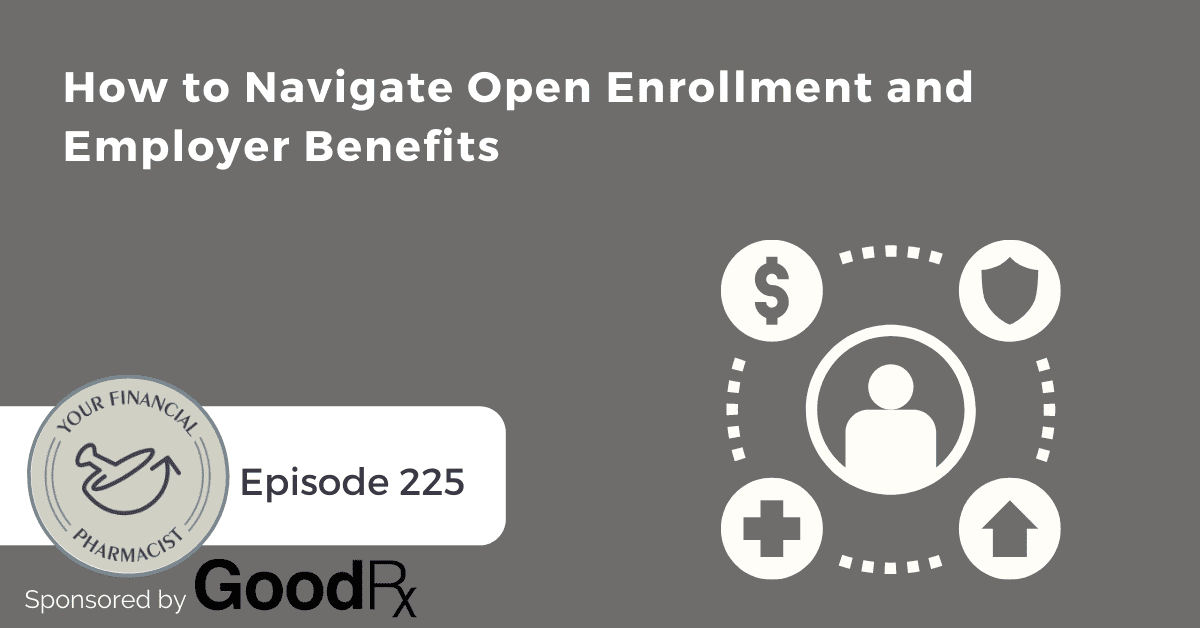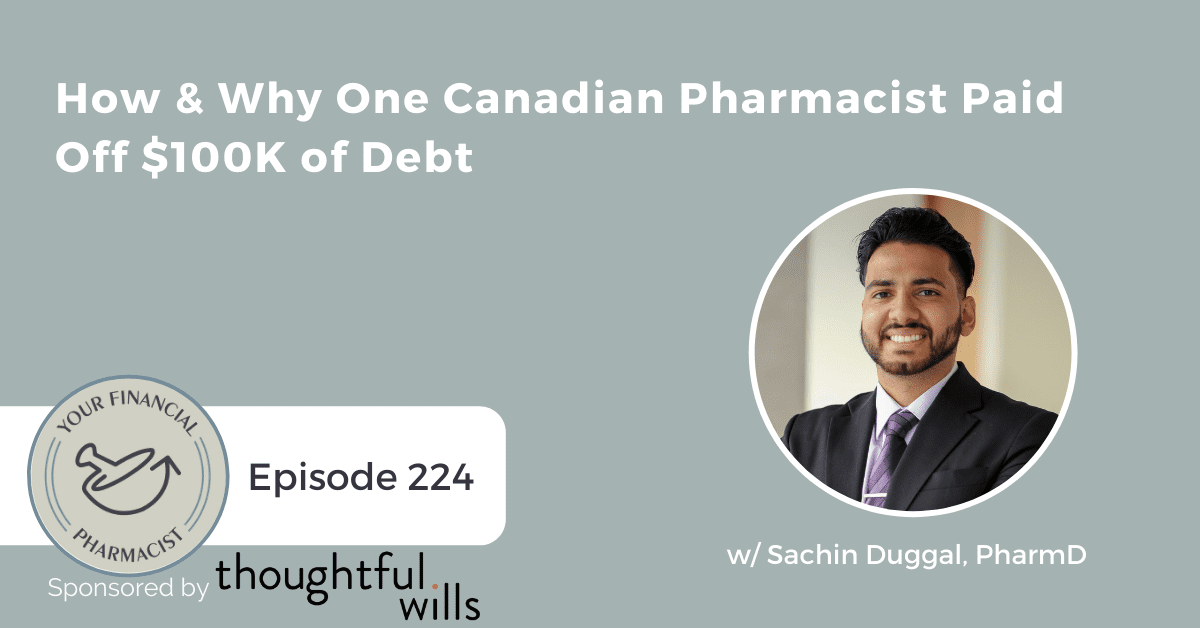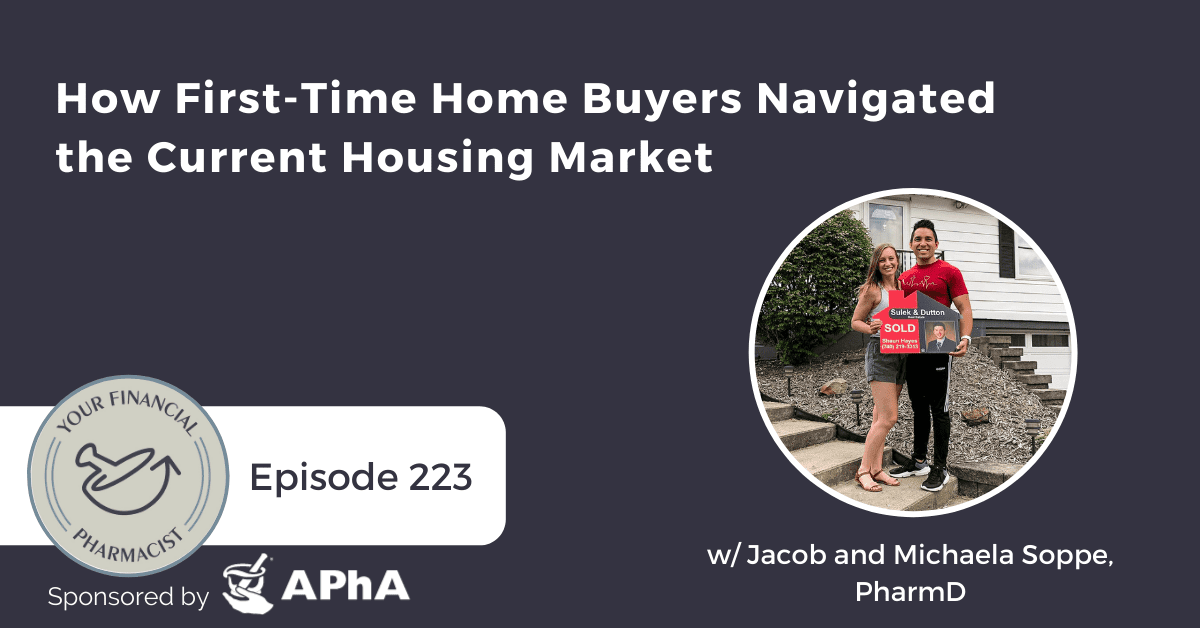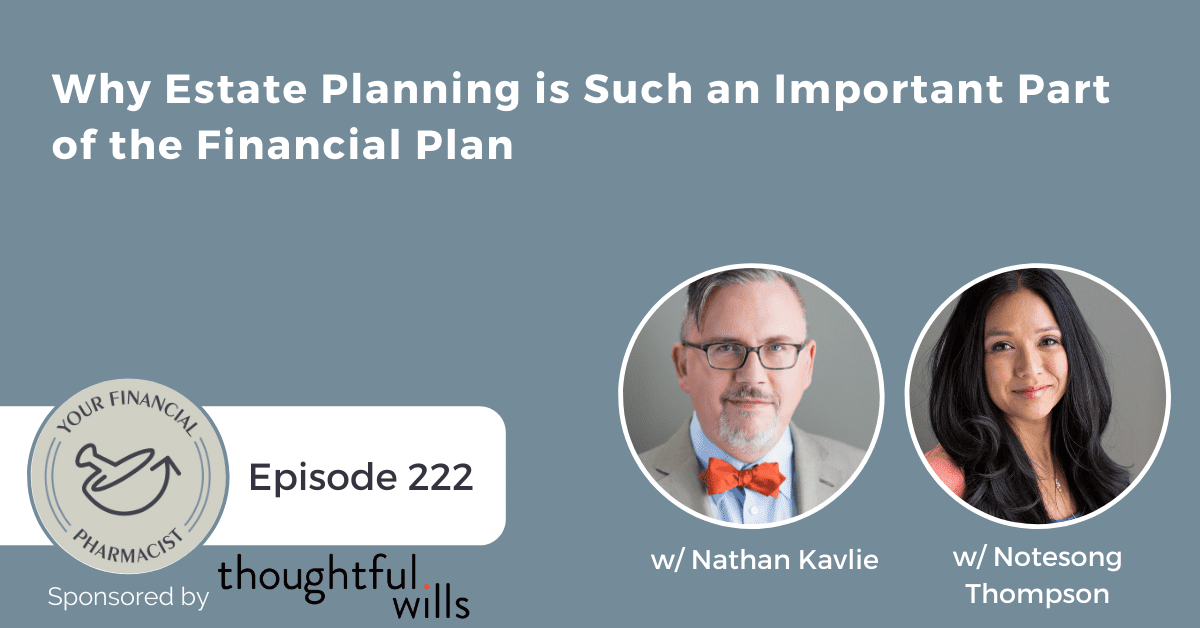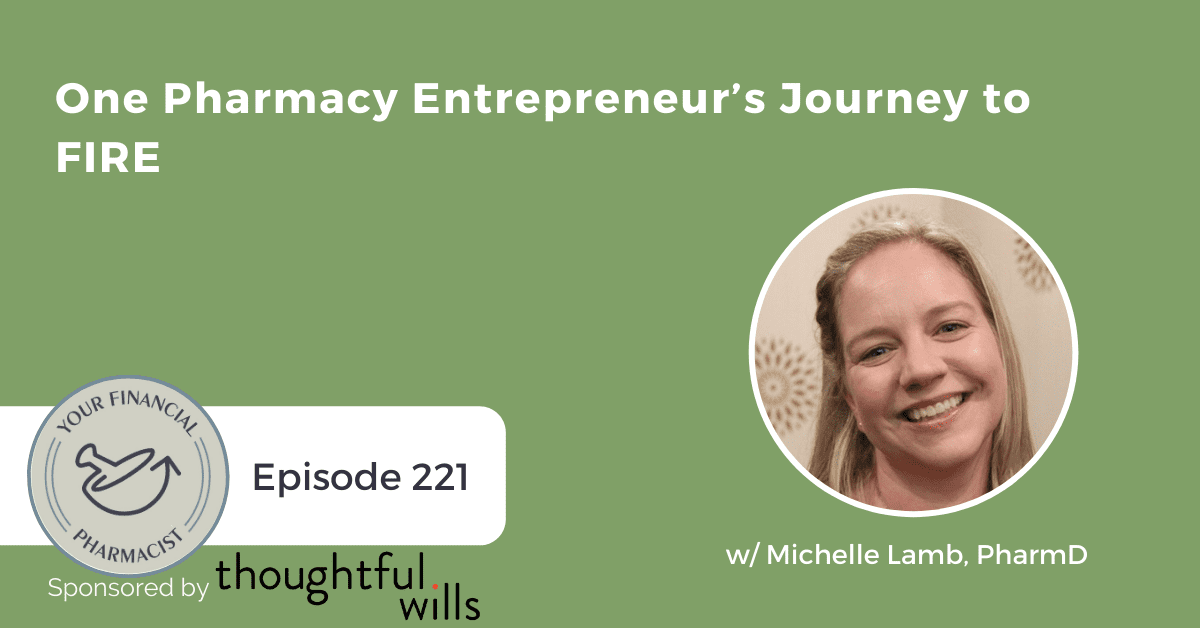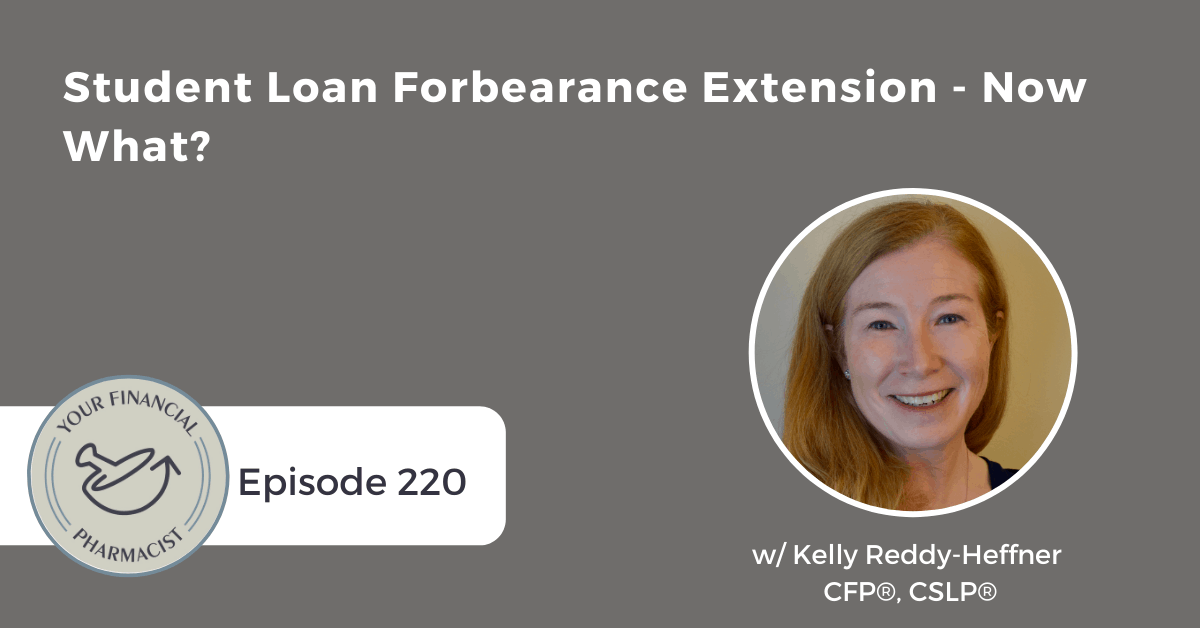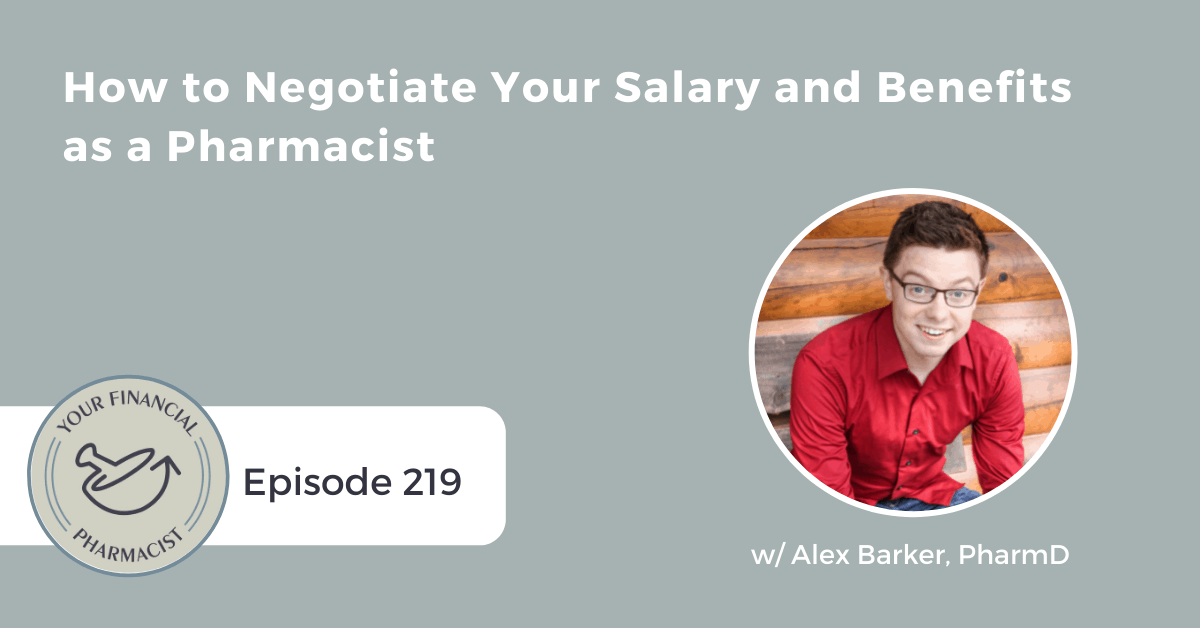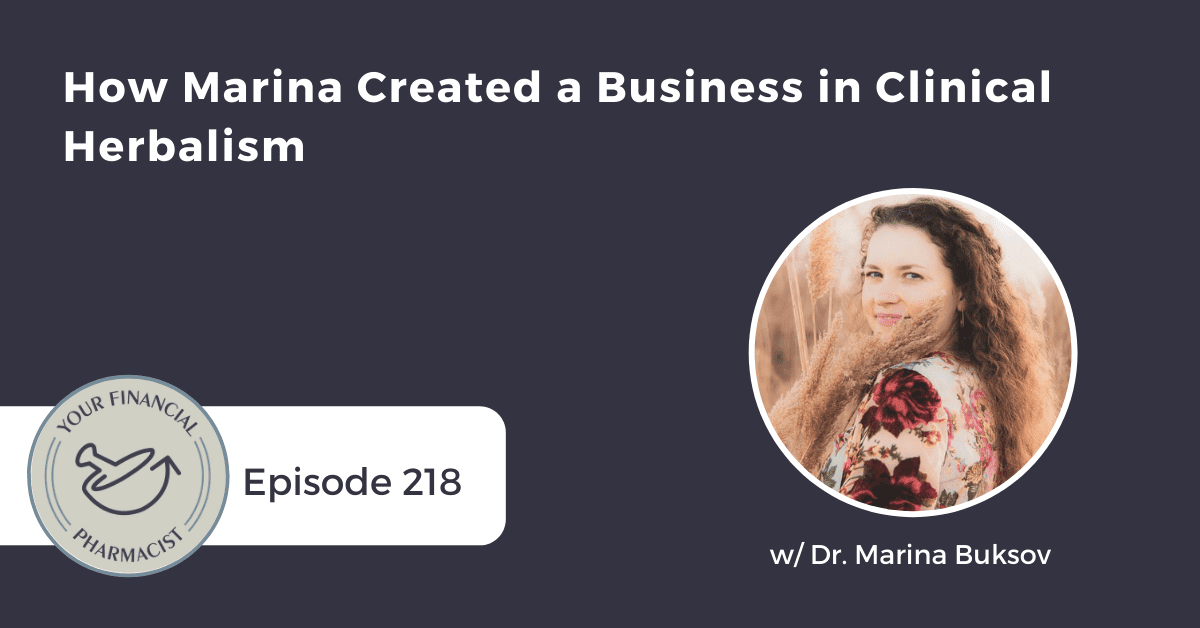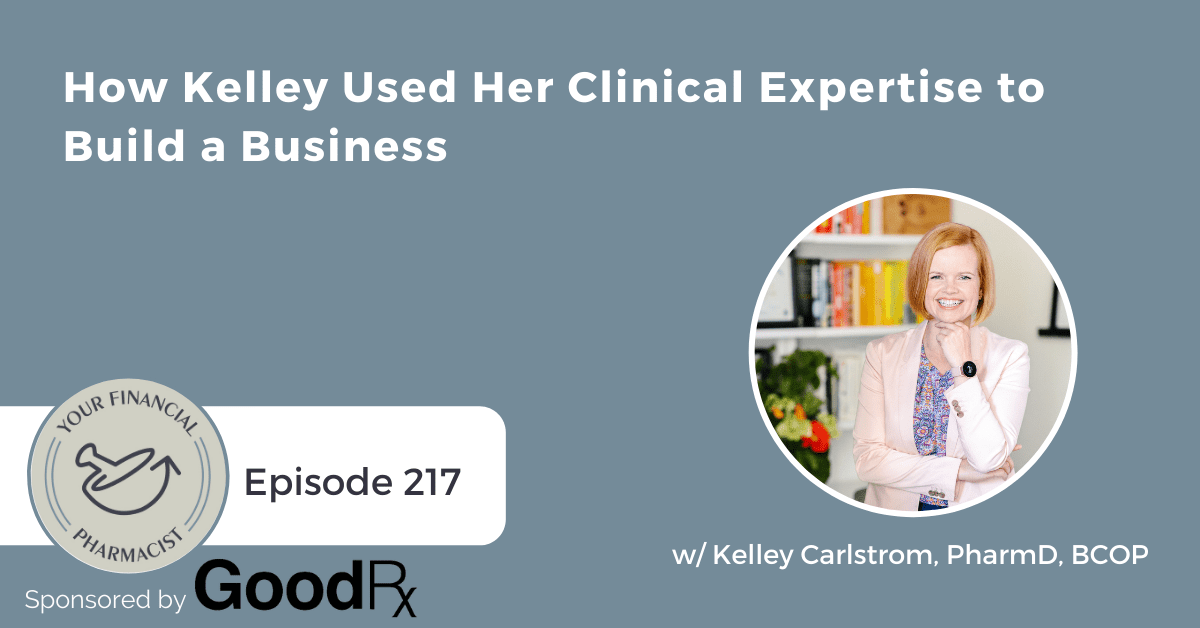How and Why this Entrepreneur Left a Successful Pharmacy Career to Start a Business
On this episode, sponsored by Thoughtful Wills, Tim Ulbrich sits down with pharmacy entrepreneur, Dr. Christine Manukyan to discuss her why for leaving her career in hospital pharmacy administration, her passion for building a business around functional medicine, growing pains she has experienced in her first year of business, and setting a bold goal of growing her business to $1M in revenue per year by age 42.
About Today’s Guest
Dr. Christine Manukyan is the founder of the Functional Medicine Business Academy™, best-selling author, STORRIE™ podcast host, and an international speaker. Prior to becoming an entrepreneur, she spent 13 years in corporate America. In the midst of a global pandemic, she made the wild decision to leave her reputable job as a Clinical Pharmacist to start her virtual practice. She is now disrupting the way clinicians are able to make an impact by coaching and mentoring them through the foundational steps of holistic practices and entrepreneurship. Dr. Christine created the world’s first Functional Medicine Certification Program which is a business incubator for clinicians to launch and scale their Functional Medicine Practice as they become Certified Functional Medicine Specialist™. Her mission is to pave the way for other burned-out medical professionals struggling to balance family, career, and their health to take control of their freedom and create their Functional Medicine Legacy.
Summary
This week, Tim Ulbrich takes some time to sit down with fellow pharmacy entrepreneur and all-around rockstar Dr. Christine Manukyan. Christine is the founder of Functional Medicine Business Academy™, best-selling author, STORRIE™ podcast host, and an international speaker.
Christine talks about her reasoning and motivation for leaving her successful career in hospital pharmacy administration. She shares her passion for building a business around functional medicine and how it aligns with her personal and progressional goals. As we know, when a business experiences rapid growth, there can be growing pains. Christine details some of her challenges during her first year of business and how coaching and professional guidance helped her overcome those difficulties.
There are no signs of her slowing down either! Christine talks about setting a bold goal of growing her business to $1 million in revenue per year by age 45 and why she recently decided to go bigger, moving that goal up by three years to the age of 42.
For Christine, mindset is critical for success! She encourages pharmacists and entrepreneurs alike to visualize what success and an ideal life look like and act upon that visualization by becoming all of the things you set your mind to become.
Mentioned on the Show
- Functional Medicine Business Academy
- STORRIE Podcast
- YFP Planning: Financial Planning for Pharmacists
- Book a free Discovery Call with YFP Planning
- Create a Comprehensive Estate Plan with Thoughtful Wills
- Pharmfluencer Summit
- Founder of Functional Medicine Business Academy™️, Dr. Christine Manukyan is Leading the Functional Medicine Revolution
- Tony Robbins Coaching
- Unleash the Power Within: Personal Coaching to Transform Your Life by Tony Robbins
- Dr. Christine Manukyan
- Sign up for the Free 5 Day Masterclass: Launch a Virtual Functional Medicine Practice in 90 Days on October 25-29
- Human Design with Jenna Zoe
- The Unstoppable Entrepreneur, Kelly Roach
- Pivot with Purpose: The true stories of how 18 female entrepreneurs & business owners pivoted during one of the most unprecedented times in history by Rebecca Cafiero, Elise Cruz, et. al.
- STORRIE Podcast: 45. Building Your Business: Financial Considerations with Dr. Tim Ulbrich
- Connect with Christine Manukyan on LinkedIn
- Your Financial Pharmacist Disclaimer and Disclosures
Episode Transcript
Tim Ulbrich: Christine, welcome to the show.
Christine Manukyan: Thank you for having me. I’m so excited. Thank you.
Tim Ulbrich: Absolutely. I’ve been looking forward to this interview. We crossed paths after I heard the tail end of your session at the Pharmfluencer Summit that was hosted by Dr. Kimber Booth, and I heard a little bit of your story and said, “Hey, I need to learn more, and we have to share more with our YFP community.” And our listeners know that I have a passion for featuring various pharmacy entrepreneurs with the hopes of highlighting the many different paths that one may take with a PharmD. You know, I believe that the PharmD is a ticket, it’s a starting point, it’s certainly not the end. And I think your story, Christine, highlights just that. We also share a Buckeye connection, and we’ll get to that here in a moment, but before we jump into the entrepreneurial journey, dig into the business, the work that you’re doing now, Christine, give our listeners some background on your pharmacy journey, how you got into the path of pharmacy, where you went to school, some of your post-graduate training, and the work that you did prior to the business.
Christine Manukyan: Absolutely. Well again, thank you for having me on your podcast. This has been such a fun connection, as you were sharing like with the Buckeye connection too. Years later, who knew we are doing a podcast exchange here. This is called coming full circle, right? Well, thanks for giving me the opportunity to share my story. Well, Tim, my story kind of goes back a little bit behind my life, what happened before coming to here in the United States because I was actually brought up in Armenia, and I came to the United States when I was 16 years old. And back home, we go to school for 10 years. So after 10th grade, and you graduate school at age 16, you are actually prepping for college. So for me to graduate, my last year of school to step into like I was going to go to medical school because I wanted to do something with medicine. And coming to the States, realizing that hmm, I’ve got two more years to figure out exactly what I want to do and really kind of gave me the opportunity to understand what I really want as somebody who just came to the States, is not speaking the language, just reinventing herself as a teenager. And what I realized at that time was medicine was not a good fit for me. And I wanted to be a mom, I wanted to be a full-time mom. I was still wanting to do something with medical field and healthcare, but I decided not to go into medicine. I wanted to be a plastic surgeon back home. And here, I’m like, no, that’s not a lifestyle I would be going into. So I literally just started doing what everyone else does, just asking people what they love about their job in the healthcare space and just kind of to narrow down my choices. And I was stuck between optometrist and pharmacist. And I realized I’m a talker. I like to talk to people. And those few minute conversation in the optometry space was not going to give me a whole lot of that connection, so I decided to go into pharmacy space. And started my undergrad — and so back then, we didn’t really have to have bachelor’s to get into pharmacy schools. And I remember, you know, applying to pharmacy schools. And I was actually put on hold on a wait list here in California at USC and also at Western, which is here in Pomona. And literally, deciding to — like maybe this is not my time. And they’re not calling me, it’s already end of July, schools are already starting. And my family decided to move to Florida, a better life and housing prices at that time. And my brother being in real estate, we decided to actually move across from California to Florida. And I remember like over the weekend, making that decision to move my entire family. On Monday morning, I get a phone call from here, from Western, saying, “Congratulations. You’ve been accepted to pharmacy school.”
Tim Ulbrich: Oh, gees.
Christine: Manukyan: And this is like what? I literally yesterday moved across from California to Florida. And I’m going to apply to become a resident here in Florida so I can go to school here. But you know, everything happens for a reason. And so the experiences that I gained becoming a graduate from the (inaudible) gave me a whole new opportunities of taking this profession to a whole new level because I was surrounded by people who did not have my background. And the reason I’m sharing this because here in California, there’s a lot of Armenians. And people know each other’s cultures, and a lot of us don’t have that voice to educate the rest of us what we do and what we’re passionate about because there’s just so many of us, right? This is not the first time they’re going to hear your story. But being in Florida and being actually class president too, it gave me the opportunity to share my story of who I am and the struggles I went through because I was the only person in my class, in the whole school, to come from where I came from. And the reason I’m sharing this is because there was a lot of learning and unlearning that happened during that process, and I had to let go of the mindset of like, everybody knows who I am to a mindset of like, nobody knows who I am and really using your voice and your experience to become that hope and inspiration for other people who may be similar like you are, but you’ve never met them before. And long story short, I had a great experience in Florida, and so I decided to continue my education in hospital setting working in undergrad and pharmacy school and retail pharmacies. I decided this is not the career path for me. I decided to run away from retail pharmacy, and I committed to a two-year residency at Ohio State at the health system pharmacy administration. And it was such an incredible experience being in Midwest, which was my first time, and experiencing that cultural shock. I’m like, whoa, this is whole new world that I stepped into. And literally being there for two years and learning so much. And I just remember like graduating, saying like, “I have so many opportunities to go anywhere I want and do so many different things,” but I really have to find something that was aligned with my passion and my soul, which was not only leadership but also making an impact that hasn’t been tapped into in the past. And I was looking for creative positions. I was looking for — the titles didn’t really matter to me. It was more about what I will get to do in the position that I’m hired to do, you know? And that questioning kind of brought me back to California again at that time. And I was hired as a regulatory compliance officer at Cedar Sinai, which was a brand new position that was created literally during my interview, I’m not kidding. It was created literally during my interview because they saw the passion that I have like creating new projects, and I was given this opportunity to do that. So — and that’s how my journey came from becoming, you know, here an immigrant starting to learn the language going to pharmacy school and residencies and landing to my one and only job that I had for 12 years at Cedar Sinai in different leadership roles, working as a clinical pharmacist and also different roles in the hospital before I left.
Tim Ulbrich: Such a cool story. And we’re going to talk about that journey out and why you made that shift, but you know, just to reflect for a moment, you mentioned being waitlisted at a couple pharmacy programs to then entering, of course I have a bias being connected to that program as well, but then entering into one of the top health system administration programs, highly selective programs, and then a job being created for you during your interview. So talk about making things happen, right? I mean, just an awesome example of that. So 2009 to 2020-ish or so, you’re in that position at Cedar Sinai, very stable career. You know, I think it’s a position many would look at in the profession and say, “Hey, I want a job like that. I want to do what Christine is doing.” You certainly invested a lot of time and money to be in a position like that, but as you noted in an article that was recently published on Yahoo — and we’ll link to that in the show notes — you noted in August, on August 13, 2019, you said, “I wrote a letter to myself manifesting how I will retire at 40. I had no plan how it will happen. I had no clue what would I do if and when I retire from corporate. I just had a huge why.” So what was that why, Christine? Why make that transition out and ultimately become what you’ve mentioned before of really being a corporate dropout?
Christine Manukyan: Oh my gosh, thank you, Tim. You’re bringing me back incredible moments of creating and manifesting. But when I wrote that letter, Tim, I was stuck. And I know a lot of us go through school, we land in this fancy jobs, our dream job, it’s happening, we’re making the income that we want, but I just knew deep inside I was not happy. You know, from outside, I had everything figured out. I was making the money, I was healthy at that time, and it was just — I was broke inside. And I just did not feel like — like why did I work so hard? Like is this it? Is this what I signed up for? I was just really like finding ways to get out of where I was stuck in. And I just didn’t know what it was going to look like or what it was going to be, as you’re mentioning. But my why was I was just so tired of choosing between family and career. Having two kids and back-to-back, and my husband also being in a hospital setting in the pharmacy administration, like we literally spent less than an hour or two at home together as a family. And I keep asking myself, why are we making all this money? Like for who? For whose dreams we are creating and building? And when I say I was broke inside, I was like, I was not happy. I would come home, I remember, and I would be so tired and so stressed out and you know, just physically exhausting as well as driving two hours every single day, sitting in my car. So I would come home and the kids like, of course they’re excited to see us, but I was not a happy person, you know? Because I was bringing that frustration, that stress from work, to home. And here I am, looking at myself saying like, I’m not a good parent. Like I’m providing the physical stuff, you know, we have a house, we’re so blessed to have a car and all these things that a lot of people would love to have, but I was not the parent who was fully present. I was not the parent who had the energy to like hey, let’s go out for a bike ride like at 7 p.m., you know, before it gets too dark, right? I was just not there, and my why was like, I need to become a full-time mom. I need to become a mom who is present and is no longer choosing between family and career. And I want to create a lifestyle that I get to choose how I spend my day, I get to choose who I spend the day with. And yes, I did not have anything figured out, but I just manifested and I wrote that letter to myself on Aug. 13, and just saying like, it will happen. It will happen. And I’ve been manifesting to kind of having an exit strategy for my 40th birthday, which was like literally a year later, and just focusing on who I want to become. And this kind of ties into like one of my favorite quotes, and I write about this quote in my book as well too. It’s by Paul Coelho. And it says, “Maybe the journey is not so much about becoming anything. Maybe it’s about unbecoming everything that isn’t really you so you can be who you were meant to be in the first place.” And I remember reading that quote, and I said, you know what, I’ve been working so hard to become this person, to have this title, to have this impact in this pharma space. But I’m like, I’m not happy. My passion is in holistic health, which is like a couple — technically opposite of what I’m even doing as my job — and just really giving myself permission to say, it is OK to unbecome who I was thinking I was going to become so I can actually step into this space and create this identity, this new identity of who I am supposed to be becoming in the first place. So that was my why, like literally figuring it out, how I’m going to have an exit strategy, creating my own legacy, creating my own lifestyle so I can live my day the way I want to and I no longer have to come home and bring the frustration and stress to my house, to my kids. They didn’t deserve to have a mom like that. They did not deserve to be, you know, having somebody in the house who was like always like impatient and you know, not really having this deep down conversations, like taking the time and really enjoying parenthood because time was going by fast. And I did not realize how my son was going to be — my oldest was going to be 10 years old. And I’m like, oh my gosh, I’ve been a part-time parent for a decade. Like what the heck? What the heck? This is enough.
Tim Ulbrich: And I think in the experience I’ve had just getting to know you and I’ve read this in the Yahoo article as well, you talked about the importance of manifesting and visualizing the next big goal. What I love about what you did on Aug. 13, 2019, is you didn’t have the path figured out, right? But you knew there was a strong why. And you know, we talk about that often on the show about how the why becomes the compass of where you’re going. And that why and I’m guessing that step of writing that letter and the visualization that came from that really probably helped inspire so much that would come over the next year. So one year later, Aug. 13, 2020, you turned in your two-week notice. So tell us about what the plan was. You had a whole year to kind of reflect on, OK, I know the why of where I’m going but how I’m going to get there, you know, somewhat TBD. You turn in that two-week notice a year later, what is the path and the work that you’re going to be doing? And tell us more specifically about some of the passion behind holistic medicine and functional medicine.
Christine Manukyan: Oh my gosh, yes. So you know, when you put your ideas and your energy out to the universe, the right people will show up. And I remember as soon as I wrote that letter and started manifesting that, the first thing I did, Tim, I don’t think I’ve shared this a lot of places, but I changed all my passwords and everything around me to say that I retired at my 40th birthday. Like I was claiming that.
Tim Ulbrich: Oh, that’s cool.
Christine Manukyan: I retired at 40. I am retired. I am 40 and free. Like anything that was around the mindset of like my 40th birthday, which you know, was like a year later, like I am free. Like I’m finally free. And I’m creating this lifestyle. And as more I was saying that, typing those passwords every single day, and the right people came into my life. And that’s when like a complete stranger became my first business coach that I ended up hiring January of 2020 to learn all about functional medicine entrepreneurship in general. How do I take my knowledge that I’ve already created all these years into getting monetized for what I want to do? And this is where my passion is aligned. And around the same time too, January of 2020, I committed to becoming the biggest fan of Tony Robbins and really invested in his coaching, in his training with one of his mentor — one of his coaches, Chris Akutchez, KK, and really being in this mindset of like, I am going to create something that has never been created in the past because I’m going to stick through this process, I’m going to focus on my why, and the how will come. It was just the process. It was a process. And I remember, you know, getting ready to go to Tony Robbins’ event in March, and the event was canceled. And I was so looking forward for that event because I needed that breakthrough. I needed to be walking on the fire and just having the guts to like just go all in. And of course with the pandemic, everything got canceled, and I was like, maybe this is not my time. And again, we kind of hold back again because you’re looking forward for an event for this breakthrough and it’s being taken away from you. But I love Tony Robbins and what he’s done, and he’s such a visionary. And what he ended up doing was he actually created his event virtually, which he’s never done before. And between March and July, he created this online space. He built his own platform to deliver Zoom to 25,000 people. And I was one of those 25,000 people for the first time ever be on his virtual event, “Unleash the Power Within,” which was end of July of 2020. And coming out of that event, I did not walk on fire, but I did break a wood. I became a wood breaker and like really breaking through the fear of failure because, again, I was mentally stepping into the space of like, I’m going to retire. I’m going to get out. My birthday is coming up. It’s going to happen. It’s going to happen. And physically breaking that wood and really passing through that fear of like what can go wrong and focusing on what can go right and really coming out of that event, I said, “This is it. I’m going to be looking at my calendar. Sometime in July or August to pick a date that I’m going to tell my boss when my last day is going to be.” And as I’m like literally like, I swear to God, like literally staring in my calendar, right, and I’m like, which day will make more sense? Do I give a three- week notice? Do I give a four-week notice? Do I give a two-week notice? Because I’ve been there for so long, and I don’t want to just like leave people hanging. And I was highly trained. People didn’t have the job that I had. And I had to train people to come into this role. And as I’m like literally staring at my schedule, staring at my boss’ schedule, and literally at the same time, I get a pop-up message saying like, “You’re scheduled for your annual performance review on Aug. 13 of 2020.”
Tim Ulbrich: Oh my goodness.
Christina Manukyan: Tim, I saw that come through my inbox and I like literally like froze. And I was like, oh my gosh, what? Here it is, universe deliver — like helped me to make that choice of not overthinking what’s the right way to do it. And I was like, this is it. This is the date. And I keep asking myself, why is this date so familiar? Like what happened? And found my notebook and I saw the letter that I wrote. I was like, oh my gosh, it has to be on this date. And I remember just sitting going into the review — of course I didn’t say anything, and we start having conversations. And like a few minutes into the conversation, I said, “This is not going to be a performance review meeting as we thought. This is actually my two-week notice to turn in,” and because this is the legacy that I’m creating, this is where my heart and passion is aligned. And again, my why was like, I want to be home with my kids. I want to be home as a parent who is still making an impact and the income that she loves and deserves, but I’m also a full-time mom. I’m also present. And it was one of the hardest decisions to do. It was one of the scariest decisions to make. But I just knew that I knew that I knew I will figure it out. I will figure it out. And I said, “This is the time. This is the time for me to create. This is the time for me to step into this new identity that I always talk about,” reinventing yourself and aligning your passion to your purpose and bringing greatness to the world. So that was my story of how I turned in my two-week notice during my performance review. And that became my exit strategy because I had a plan, but again, I did not have everything figured out. I couldn’t wait any longer, and I’m going to say this too because there’s so many people who are probably listening to this and saying like, “Well, that was easy, like you just left your job.” So I wonder if she really made enough income on the side doing her side gig. And the answer is no, Tim. I did not have everything figured out because it was really hard to create this legacy on a full-time basis if I was still working full-time, miserable, in a job that I had. I could not physically and mentally create the legacy that I could have created if I did not have the job. You know? So no, I did not match my income. When I left, I left my job making less than $1,000 on the side. But I just knew I can make things happen because now I’m like 100% in, I’m all in, and my energy is flowing in the direction of creating and nothing can stop me. I am unstoppable. That’s my thing.
Tim Ulbrich: I think it’s a great reminder, Christine, too — I was actually listening to something this morning reminding me of Tim Ferriss’ work when he talks about really leaning into the fear, right? So you’re talking about giving a two-week notice and what does that mean, you know, in terms of not only next steps for the business, but you know, as you mentioned, it’s not like you had everything fully fleshed out, what does this mean for the family. But you know, folks might be listening that whether it’s a jump to another job, whether it’s making a decision to go part-time, whether it’s another fear that they may have, is that the thoughts that we have around that fear can quickly seem as if they’re reality. And we need to just sometimes lean into that a little bit. And I encourage like as you’re weighing a big decision like this and you feel like that fear is taking over, like literally think of the worst case scenario and start writing it down. Right? Because I think once we start to make it a little bit more objective and get it out of our head a little bit, I think we can start to at least begin to wrap our arms around it and process it and not be paralyzed by that fear. So it’s just such a great example of that. So tell us more about the work that you’re doing right now. We’re going to link to the website, of course, DrChristineManukyan.com, we’ll link to that in the show notes. Tell us more about the work that you’re doing with the business, the why behind that work, the problems that you’re trying to solve, and ultimately the products and services that do that.
Christina Manukyan: Absolutely. So I am a huge believer in giving people opportunities and choices. OK? And going into pharmacy space, like we were not really being given choices. It was just like, this is the protocol, this is how you treat stuff, and this is what we do, right? There’s no like, let’s try this, let’s try that. No. We were just given a recipe, we just go with that. Right? And when I was going through my own health transformation too, I realized like I was craving having choices in life. I wanted to have other options so I can weigh in and make that decision of like, how do I want to lead and treat my health? Right? And so that choice was given to me, which was functional medicine, which was holistic health, and really understanding like, let’s dig in deeper and get to the root cause of what’s making you sick. Again, part of my health transformation was at age 35, I was told by my primary care physician I was going to have a heart attack and I was going to die by my 40th birthday in the next five years because I was morbidly obese, I had extremely cholesterol, I was extremely burnt out. The stress was killing me. And I was told I need to take a pill. I was given a prescription for Lipitor, saying, “Go take this pill, try to lose some weight,” some weight — nothing about nutrition, right — and if you don’t do all these things, you are going to die. You are going to die. And this was not something that I wanted to receive. And I said, “Lord, there has to be a better way. There has to be something else that I can do that is going to save my life.” Not change my life but save my life. And that was holistic health and functional medicine. And when I incorporated that and started doing the cleanses, started bringing adaptogen into my life and really feeling like a new person and as a result, I lost over 100 pounds. As a result, I became a bodybuilding fitness athlete. And as a result, I ran the LA Marathon March 8 of 2020.
Tim Ulbrich: Awesome.
Christine Manukyan: I mean, this was how I was stepping into my 40th birthday of being like healthy and fit and physically and mentally and emotionally and I was not broke anymore. You know what I mean? And when I saw this is a missing tool that a lot of us clinicians feel like there is a huge maybe stigma associated to like why would you recommend an herb versus a proven medication that has all these studies to that? Right? And I became the voice for other clinicians who are literally struggling themselves too to take care of their own health because burnout is legit. It’s happening to all of us. And they want to get healthy, but again, they just don’t know what else is out there. They may have heard about holistic health and functional medicine, but they have themselves not tried it because their mind has not been opened to learning what else is out there because we have not been given this education training. We can’t blame anybody else other than our education. Like that’s happening right now. And creating that space to train other clinicians, No. 1, taking care of your own health, utilizing functional medicine, but also as a result, as you’re working on your own health transformation, I’m going to show you how you can turn this into a business model that you can get paid for the same services that you’re applying for yourself for other people because there is always somebody out there that is praying for someone just like you with your own zone of genius to come into their life to save their life. So it becomes this process of like take care of your own health first, understand functional medicine is a tool for you, become your own transformation story, so now you can become a mentor for someone else. And that’s how the academy, the Functional Medicine Business Academy was born. It’s more than business coaching. It’s also reinventing yourself, who you are as a human being. And all of my clients and our clinicians and we are not only creating business models but we’re also transforming our own health because if we’re not healthy, we cannot serve everyone else, especially nowadays when there’s just so many moving parts and so much stress associated with life in general, so much uncertainty. And what we’re trying to create is like focusing on our own health. You’re not being selfish. You’re learning as you’re going, and you’re also creating your own functional medicine legacy so you can one day have an exit strategy if you choose to do that. And that’s how the academy has been growing and constantly adding new things into that. Collectively, we are all going to be writing a book that’s going to be published very soon, “Unleash the Story Within,” scheduled to be released on Nov. 9. And these are all clinicians who are telling their own transformation journeys, how they went from traditional medicine to functional medicine, and what their own health transformation with functional medicine and holistic health looks like. I’m a storyteller, so it’s all about getting your voice out there because there’s always somebody out there that is literally praying for someone just like you to come into their life to save their life. And really creating this tribe and starting the functional medicine revolution and giving our profession an upgrade, I’m going to say. Maybe not the right word to use, but really telling the world like, we are clinicians. Yes, we are pharmacists, we didn’t learn this in school, but we have tools to become certified functional medicine specialists through my program and really use our knowledge and experiences but not become a specialist in functional medicine space. So upgrading your PharmD to a specialist of functional medicine because this is an opportunity that was not given to us from any ways and now I’m becoming the voice for our profession to say, “You can do this too.” And the Board of Pharmacy will not show you how to do that because it’s not written there yet.
Tim Ulbrich: That’s right.
Christine Manukyan: Yet. It will one day. Yes. It’s all about starting the revolution and really giving us that platform to practice what we’ve already learned but also blend in and integrate functional medicine into our practice so we can give people options and give them choices, you know?
Tim Ulbrich: And we will link to the website, again, DrChristineManukyan.com, you can learn more about the academy, the Functional Medicine Business Academy, as well as an upcoming free master class on Oct. 25-29. And we’ll talk more about that here at the end. Christine, you know, I was thinking recently that I have lots of conversations with folks where they may have an idea and I think some of those ideas stay just as that, as an idea, a small percentage of those end up with some action of those that people take action, sometimes folks see results and then a lower percentage of those you actually see results where folks can replicate that, scale that, grow that to where they’ve got an actual thriving business. So as you reflect back on your journey from ‘I have an idea,’ and you mentioned leaving your position where you hadn’t yet fully fleshed that idea out to where you are today now and the business really growing and scaling. Was there a specific moment in that journey where you realized that this idea that you had was really an idea that had legs and one that could be sustainable as a business?
Christina Manukyan: Ooo. This is such a huge question, Tim. I’m going to say yes. And this all also is connected with who I am as an individual when I make decisions. And those of you who have not done human design, I would highly recommend all of you to do that because it also dictates how you make decisions and how you see yourself in this world. And I make my decisions, Tim, based on my gut. And that’s how I am the visionary who executes it, even though if I’m 80% sure, I will execute it to the finish. And that’s how I was humanly designed to make decisions. This is not for everyone because a lot of people don’t make decisions with their gut. They are actually thinking it, right? I have to feel it. So we’re all designed differently, and if you’re listening to me and you’re like, wow, I would never do that because that’s fine. Find the way that you can actually execute it based on your own human design. So do that thing, and there’s a website you can actually go and it’s completely free, will tell you who you are. But for me, it was knowing like I don’t have another choice. Because I can continue doing this, I can continue living my life, or I can take this other path of creating something that has never been done before. And this may be part of my process of coming to the United States and being an immigrant. I was not given a lot of choices when I was here as an immigrant. And I had to figure things out. I had to learn things that I have never seen or heard in the past. I gave myself permission to not be scared because your body cannot tell if you’re scared or excited. It’s the same neurotransmitter that you’re experiencing that. So instead of saying like, “I’m afraid to make this decision and execute,” I’m going to say, “I’m excited about the opportunities that are to come.” So really put that into excitement versus fear. But most people are stuck in the fear and not executing. And again, I wanted to have — I’m one of those people who likes to try new things and not being afraid of failure because that is just not an example of how you can learn and grow but also want to become a voice for my kids, Tim, because being an immigrant coming here, I watched my mom work like three jobs to provide for us. And I said, “This was hard.” And her sacrificing her own health to provide for our family is actually causing her have three autoimmune diseases, like here like 20 years later. You know? And I don’t want anybody to sacrifice their health because they’re trying to create the wealth that they need. I want everyone to have choices, and I want my kids to grow up saying like, “Mommy and Daddy made this decision,” and we are creating generational wealth. We’re not just taking care of ourselves now. I’m creating a generational wealth so my kids are growing up and they’re saying, “Mommy made this decision, you know, like when she was 40. And she created this legacy because now I get to do this.” So and it all starts with, again, going back to the simple things of understanding your why and why you want to do that, and everything else will fall into place. And just follow what makes you happy. And go back to asking yourself, what do you desire? Like I was desiring to be a full-time mom first. I wanted to be — I was desiring to be a somebody who was happy not for the world to see but I was happy inside. And I was not broke anymore. And I was living a fulfilled life, not for social media to see the highlights, but I was really, really like living that happy lifestyle that I know I can inspire someone else saying like, “You know what? Enough is enough. This is my time to rewrite my story,” and they can connect and make that transformation journey themselves and really step into the new identity that they should deserve and they’re part of it. So.
Tim Ulbrich: Christine, I am. I am. You said that if you’re inspired in any way — and I’m taking, again, this from the Yahoo article — if you’re inspired in any way, write a vision-casting letter to yourself and use the “I am” statement when you’re describing your life a year from now. And you say, “I challenge you to have this everywhere. I had it on my screensaver. I had it as my passwords that I was typing every day. I mean, it was everywhere. I was saying it until it became real.” Tell us more about that “I am” statement.
Christine Manukyan: There’s something about this like psychology and that again, I didn’t learn about this, but again, hiring a lot of mentors and business coaches and mindset coaching like and understanding your mind is capable of doing so much, and I decided to claim I am corporate dropout. Also I am Wonderwoman. And those of you who haven’t seen my Wonderwoman transformation as a fitness athlete on stage and really owning like having that mindset that goes with the image that I’m creating. Like who am I? Right? And Wonderwoman was actually my nickname in my fraternity, Phi Delta Chi, and I was like, who is Wonderwoman? I’ve never heard of her name, right? And when I was given that name back in pharmacy school, I literally had to Google like Wonderwoman because again, I have never seen her or heard of her, right? And I was like, this is somebody I want to be. And I think just even having that name that was given to me back then, like I was — I am Wonderwoman in my fraternity Phi Delta Chi. And what that allowed me to do is to become like a Ro Chi. It allowed me to become the class president and FSHP president and Phi Lambda Sigma president, right? Because I was stepping into this like who I am. My name might be Christine Manukyan, but I am Wonderwoman. I am unstoppable. And really claiming that and more excited — I’m not going to say scared — more excited you are when you’re saying those words and you’re owning it, psychologically and physically, you are going to become. OK? You’re going to become. And I have been, the last couple of months, I have been claiming of really having a million-dollar business in my business by age 45. But I’m actually, after attending this event the last couple of days, I am going to challenge it and change it to by 42nd birthday, so by next year, because I’m really pushing myself to the next statement of like who I am and also honoring the transformation that I’m going through myself. It’s not just like saying it, like “I am Wonderwoman.” Well, what does that mean to you? What does that mean to feel things and how do you show up? How do you talk? How do you dress? Who are you surrounded with? How do you spend your time? How do you spend your money? What relationships do you have? Right? Like who is that person that you’re stepping into? And when it actually happens, you’re like, ‘Of course it was going to happen.’ It’s like you’ve already done the rehearsal. You’ve already created that space. And you know, I talk a lot about this during my master class too, Tim — and thanks for mentioning that — understanding like the ideal life you want to create for yourself and why you want to create that. It sounds so simple, it sounds so cliche, but I want you all to actually physically experience like what would it mean if you say like, ‘I want to let’s say retire in xyz years,’ or ‘I want to actually wake up one day and not have migraine headaches anymore,’ right? Whatever it is that you’re desiring, whatever your ideal life looks like, I want you all to actually experience that right now. It’s like running a drill. It’s like running a drill, right? Like you practice it now so when the day comes when it’s the right time to show up in your life, you are able to receive that information, you are able to see the transformation that the universe will deliver to you because you’re focusing your energy and your mind in that direction.
Tim Ulbrich: Yeah, no, that’s great stuff. And I want to share, you know, as we feature more pharmacy entrepreneurs on this show, you know, I think that for folks that have an idea in mind and they hear someone who is taking some calculated risks, has taken that step, has had some success in that, they can get excited, right, about that and start to hopefully visualize and dream that if that’s something that they’re passionate about as well. But it’s also important that we talk about the growing pains, we talk about what we do when we feel overwhelmed or unfocused. You know, it’s not always rainbow and butterflies. You and I know this from firsthand. And so when we share these stories and we talk about some of the positive outcomes of these dreams and visions that we’re also talking about the reality of what it means to be running a business. So Christine, as you reflect on what has been a very short period of time and the success you’ve had thus far, as you’ve gone from idea to validation of that idea and now the business really growing, you mentioned $1 million business goal that you have by your 42nd birthday, I suspect there has been some growing pains as you’ve had some success, right? I know you and I talked a little bit about things like corporation structures, right, and tax situations, and other things that can feel overwhelming at times as a solopreneur. So tell me about some of the growing pains that you’ve experienced thus far.
Christine Manukyan: Oh my gosh, yes, Tim, we were talking a lot about that. And again, sometimes you just don’t know what you don’t know.
Tim Ulbrich: That’s right.
Christine Manukyan: And for me, I have made a lot of bad decisions hiring people. OK? And this is huge because we always say, you know, when you have business growing, you need to hire help. Well, that’s great. But who do I hire? How do I know they’re the right fit? How much do I pay them? Are they a contractor or are they — just so many things. And I have made really bad decisions the last few months because I was desperately looking for someone that my unicorn, and I was like, OK, I will train them. I’ll give them this opportunity, but they were not the right fit for my company. They were not seeing the vision that I want to go. Like I’m creating, I’m revolutionizing how our system and how people are going to learn about holistic and functional medicine and creating legacies. Like there’s nothing has been done the way — the scale that I’m going. And the people I was bringing on board, they didn’t see the long vision. And they were just focusing on the tasks that I was giving them at this moment, so I’ve spent a lot of money, close to like $20,000, let’s just put it out there. It’s a lot of money because I just didn’t know, and I was go-go-go mode. I was like really working off of my masculine energy and just go-go-get things done and not slowing down and saying like, let me reflect who I want to bring into my company. Anybody wants to take a job right now. Like right? And they want to work with you, but did I really give myself permission to really ask like who I want to work with? I know they want to work with me, but do I really want to work with them?
Tim Ulbrich: Right.
Christine Manukyan: But it was coming from the mindset of desperation because I was like, I’m growing so fast. I need help. And I was like literally hiring people left and right. Like literally had no structure in place, I had no SOPs in place.
Tim Ulbrich: And you have an administrative management background, right?
Christine Manukyan: Yes. But again, that was structured for Corporate America, Tim.
Tim Ulbrich: That’s different. Yeah.
Christine Manukyan: It was structured for Corporate America. I cannot go get an MBA to have an online practice running. An MBA is not teaching you what to do. It’s not. And the minute I started asking myself like, why is it that I’m bringing more help but I’m even more stressed out right now? Here I am working like 12-hour days. I went from like 8 to 10 12 now. And what is going on? And I asked this to my business coach, Kelly Roach and her program “Unstoppable Entrepreneur,” and she was like, “Christine, have you put systems in place when you’re onboarding? What does your onboarding process look like?” I’m like, “Kelly, I don’t have an onboarding process. What do you mean? You don’t just hop on on Zoom and tell them what to do and where to look for information when they need your help?” They’re like, no. I’m like, oh my gosh. So I’ve spent a lot of time, which is, again, my most valuable asset that we have, bringing people on board who are not a right fit for my company. But I was doing what people told me to do, go hire some help. So I did. I went and hired some help versus asking, education — like smarter questions like what does the process look like? Explain it. Because I’ve never hired someone before. So understand that just because somebody’s telling you to go do something, like stop and say like, can you explain what that looks like? Can you tell me what would be a better fit for me and for my company? Ask those questions, and it’s OK to ask questions. You may sound like, oh my gosh, that’s such a dumb question to ask, but let me tell you, those dumb questions you feel like there’s — No. 1, there’s no dumb questions to ask. Those questions can not only save you time but money and education because you’re learning. And running a business, especially if you’re scaling and you’re creating something that hasn’t been done before, like there’s not a lot of people to like go study for you to create. You just have to go with it and put it in place and pivot when needed. And I know a lot of people say like, ‘I have the best product I’m bringing to market. And this is it. It’s going to be a game-changer.’ Well, honey, I’m sorry to tell you that, but you might have to learn how to pivot and how to make changes.
Tim Ulbrich: That’s right.
Christine Manukyan: If you feel like your ego is getting into your way to really create the product, the services that everyone needs and loves and become your biggest fans, like you have to grow and you have to pivot when it’s the right time. But a lot of people say, ‘No, I can’t do that. Like I already spent so much time and money on this.’ Well, if it’s not working, please change. It is working, keep going.
Tim Ulbrich: Yeah, and I think that’s a great example — and I have one in our business where, you know, and I think ego can be such a barrier. But we had a service that we launched that we thought was going to be a home run, and the key as I reflected on that is, you know, that was very much framed by what we thought was going to be needed by our audience and by the community not necessarily by exactly what that group was telling us what they needed. And once we could get over the ego, we’re able to move forward and cut those losses. But it’s easy to hang onto those losses, say, ‘Hey, I spent a lot of time, I spent a lot of money developing this,’ but at the end of the day, you’ve got to pivot. I think that’s a good lesson. Last question I have for you, Christine, you mentioned in this time where you’ve hired folks and sometimes that hasn’t necessarily been the right fit, probably you spent more time than it would have been without having some of those people on board, I suspect times, you’ve felt maybe overwhelmed or unfocused. What do you do in those moments? You know, as an entrepreneur, you find yourself in a period of time where it’s stressful, you’re overwhelmed, you feel like you’re unfocused, perhaps a little bit separated from the core mission of what you want to be doing in terms of spending your time and working on, what do you practically do in those moments where you’re feeling that?
Christine Manukyan: First, take a deep breath and remind myself that I am fortunate to have this type of stress in my life because sometimes, we forget this was a choice and this is an opportunity for me to overcome those barriers and recreate what I want to do, right? So first, celebrating that this was a choice. I am alive. And I get to stress about things like this, OK? But just kind of going back to like really go back to the basics. OK? And I’m such a huge like a checklist person. If you see my to-do list, you probably would have a heart attack. But it’s long. It’s very like detailed, right? But that’s also psychologically, it’s overwhelming. And what I learned was I need to break it down to like literally like maximum three decisions I have to make today. What’s the next right thing for me to do today? Maximum three things to get me closer to the next place. It may be going down the checklist, maybe re-evaluating my checklist, maybe learning how to delegate some of this to-do list to other people on my team and elevating them and training them. OK? But really asking yourself like, going back to the basics and really asking myself like what are the top three choices, decisions I need to make today, to get me a step closer? What’s the next right thing for me to do? The next one. And then like one at a time. One at a time. And that’s it. Versus getting overwhelmed with a large to-do list and it’s just too much and just you will — like you will have those days when you’re going to ask yourself like, what the heck did I get myself into? And I want you all to celebrate that feeling because again, you’re feeling stuck, but I want you to celebrate that feeling because you’re going through a transformation. And instead of getting stuck in that like oh my gosh, like what the heck did I just get myself into, just saying like, ‘Who can I call to help me just to talk?’ and maybe the one decision you need to make that day is for you to get rest, for you to have the time out, for you to create time on your schedule to create content, to create lifestyle, whatever you want to do. Like give yourself permission to block off time on your calendar to create. And you have to create that time in your schedule because we all have the same 24 hours, OK? You don’t have to do anything. Everything you do in life is based on your choices you make and decisions you make. So you don’t have to do anything. So create that time for you to like slow down and really ask yourself, what is it the maximum three decisions I need to make today that’s going to make me closer, get closer? And that decision, one of them can be like, you know what? Today, I’m taking a day off. I am just not even going to do anything because physically, my body needs to rest. And that’s OK. And that’s perfectly fine.
Tim Ulbrich: Absolutely. This has been fantastic, Christine. I really appreciate you joining and sharing your story with the YFP community. We’ve only scratched the surface. We didn’t talk about the book that you’ve co-authored along with 17 other female entrepreneurs and business owners, “Pivot with Purpose.” We’re going to link to that in the show notes. I hope folks will check that out. And as I mentioned earlier, Christine has an upcoming free master class Oct. 25-29. You can learn more at DrChristineManukyan.com. We’re going to link to that in the show notes. And this master class is really meant to help folks learn how to blend the years of education, the professional experience you have, folks that are passionate about holistic health and ultimately how to create your own functional medicine practice. And it’s going to be on Zoom Oct. 25-29. Five days learning how to identify your why, handpicking your dream clients, taking the center stage as personal branding, looking at your definition of wealth and success, and then finally redefining your scope and practice. And so much of, Christine, what I’ve heard in this interview is a lot about mindset and really thinking about how your personal mindset is going to have a positive impact on the future growth and hopefully realizing what’s possible within yourself. So Christine, thank you so much for joining us and looking forward to watching what you do in your business over the coming year.
Christine Manukyan: Thank you so much for having me, and I’m so grateful for your time as well too because you added so much value in my community a couple weeks ago, and I’m just so grateful for our relationship, our friendship and collaboration. It is definitely making this world a better place when you have amazing partners next to you. And we all share so much and I just cannot wait to see what’s next and yes, we can always, always connect with me and share your biggest takeaways because like you said, Tim, life is all about making connections and really getting to knowing people who are going to change your life. And this conversation that we had can probably change someone’s life. And I want to hear from you.
Tim Ulbrich: Awesome. Thanks again, DrChristineManukyan.com, you can also connect with her on LinkedIn and as always, we thank you for joining for this week’s episode and look forward to having you again back here next week. Have a great rest of your week.
Current Student Loan Refinance Offers
[wptb id="15454" not found ]Recent Posts
[pt_view id=”f651872qnv”]

